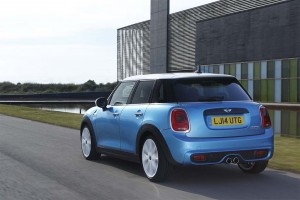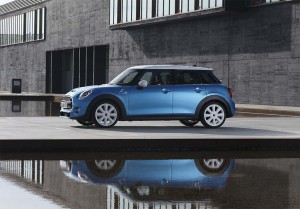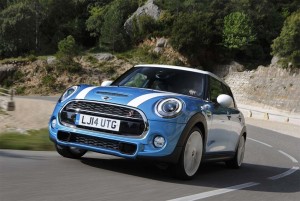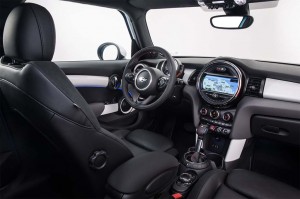It may be Mini, but the British maker’s line-up is about to get a bit bigger with the addition of the first-ever four-door version of its Hardtop model.
Confirming long-standing rumors, Mini said the new model will roll into U.S. showrooms later this year, the latest in a fast-growing line-up of niche products. Considering the success of the larger, 4-door Countryman model, it’s clear that the British maker is betting there’s a solid market for those who want a little more convenience and flexibility than the traditional 2-door Hardtop offers.
Both models will share the same underlying platform which recently went through a complete redesign – but the 4-door will gain even more length to accommodate the extra doors, and to provide a usable rear seat.
The latest version of the 2-door Hardtop itself grew significantly, adding 4.5 inches in length, 1.1 inches to its wheelbase, and 1.7 inches in width. The 4-door, in turn, gains another 6.3 inches in length and 2.9 inches in wheelbase. That translates into better head and shoulder room, as well as another 0.5 cubic feet of cargo space, now a total of 9.2 cubic feet.
(Mini concept offers sneak peek at next Clubman. Click Here to check it out.)
Though both Hardtop models are the same width, Mini managed to carve out an extra 2.4 inches at elbow height. The three-across rear seat, meanwhile, has a 60:40 split folding backrest to boot storage space yet a bit more.
Initially, the Mini Hardtop 4-door will be offered with a choice of two engines, a base 134-horsepower 1.5-liter 3-cylinder package and a 189-hp turbocharged 2.0-liter inline-four for the Mini Cooper S version. Both will be available with either a six-speed manual or six-speed automatic.
Don’t be surprised to see Mini follow with a more sporty John Cooper Works edition. It has already confirmed one is in the works for the 2-door Hardtop.
(Mini is just the latest with a downsized 3-cylinder engine. Click Here for more.)
Visually, the extra doors are the most immediately distinctive feature when lining the two new Hardtop versions up alongside one another. The 4-door’s already sloping roofline dips a little more in the rear, and the back glass is raked a little more steeply.
Beyond that, the two models share the upgrades and changes in basic layout that debuted with the new 2-door Hardtop. Notably, the maker addressed some of the more frequent complaints about its interior layout, moving the speedometer, tachometer and fuel gauge from the center stack to a more traditional position in front of the driver – albeit disappointing some Mini purists in the process.
The center display has been redesigned to handle a variety of other duties, including infotainment, and the ring is rimmed by a new LED lighting system that glows in various colors to reflect such things as the driving mode – glowing green in Eco Mode, red in Sport.
The suspension of the new Mini Hardtop was significantly revised and, among other things, the car is now be offered with a system called Dynamic Damper Control. Electronic controls allow a driver to shift between the various modes. The electro-mechanical steering, meanwhile, now adds a torque steer compensation system to prevent zigging and zagging under heavy launch acceleration.

The new Mini Hardtop 4-door adds about 6.3 inches in length and x.x inches to the wheelbase of the recently redesigned 2-door.
The new Mini Hardtop also got an upgraded version of the Mini Connected Services package, and the car will be available with either a 4-line TFT or 8.8-inch LCD display. There’s also an optional new Head-Up Display, and the new Driving Assistant adds a number of camera-based safety systems such as active cruise control and collision and pedestrian warning,
(Click Here for more on the new Mini Hardtop.)
The new Mini platform was developed as part of a joint venture with parent BMW – the German maker planning to use the new “architecture on some of its own, smaller models, including replacements for the 1-Series and X1. It will mark the first time BMW will opt for a front-drive layout.



